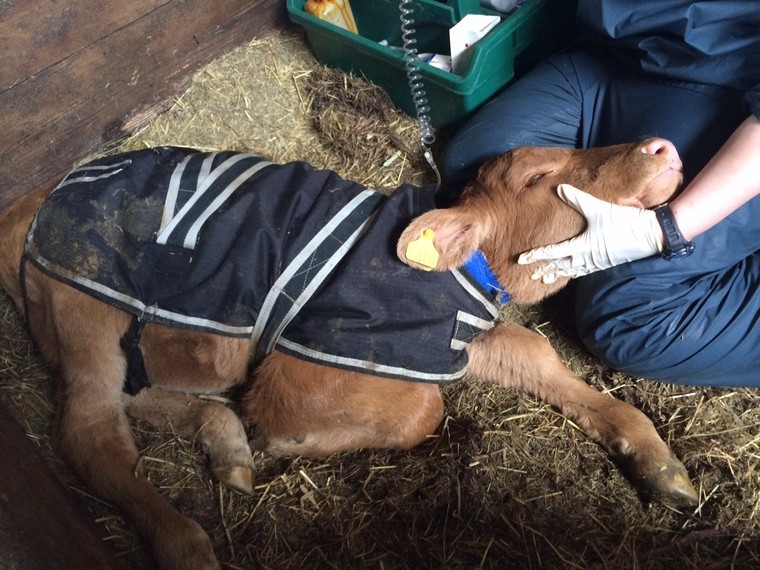Calf scour can be easily recognised, and it is important that treatment is administered rapidly in order to maximise the chance of survival, writes Tim Potter BVetMed MBA PhD MRCVS Senior Clinical Director, Westpoint Farm Vets.
There are a number of different organisms that can cause scour in calves. Viruses such as rotavirus and coronavirus are widespread and commonly cause watery diarrhoea in young calves; they can be controlled through vaccination of the cows coupled with ensuring that calves receive sufficient colostrum.
Various bacteria can also cause scour: E.coli, Salmonella and Clostridia all cause severe diarrhoea in calves. The two other main infectious causes of scours in calves are cryptosporidiosis and coccidiosis. These are caused by protozoal parasites commonly found in the environment on most farms.
Cryptosporidiosis is seen in calves as young as three days old, whilst coccidiosis is seen in animals from three weeks of age and can potentially lead to severe impacts on growth rates. Scours may not always be caused by infectious organisms. Calves will sometimes show nutritional scours; these are caused by inconsistency of feeding and can be minimised by ensuring that milk is always provided in the same way, i.e. making sure that the volume, content, temperature and route of administration (bucket or teat) is always the same.
For all causes of diarrhoea, especially in very young calves, the main part of treatment is always the same; administration of fluid mixtures to correct the dehydration and acidosis that occurs due to fluid loss from the calf’s digestive tract. The way fluids are given will depend on how severely dehydrated a calf is. Mildly dehydrated calves (only slightly depressed, still able to stand and still with a suckle reflex) will respond well to oral fluids. In cases where calves are severely depressed and the animal is unable to stand, the advice is to seek veterinary help immediately as the animal is likely to require intravenous fluids.
Your veterinary surgeon will be able to advise on the most appropriate rehydration solutions. In general, oral electrolytes should be fed as an extra meal to calves that have diarrhoea. For example, if calves are normally being fed twice a day (morning and evening) then oral electrolytes can be fed as an additional feed in the middle of the day.
There have been suggestions that continued milk feeding worsens diarrhoea and that treatment protocols should involve a period of “resting the gut” during which milk is withheld. However, research has shown that milk feeding does not worsen or prolong diarrhoea; nor does it slow down healing of the intestine. The studies also showed that continuing to feed milk alongside electrolytes maintained growth and avoided the weight loss observed in calves limited to only electrolyte solutions.
It is therefore best to continue to feed milk as per the calf’s normal schedule and add in additional electrolyte feeds. It is essential that treatment is started as soon as the diarrhoea is observed; delay will increase the probability of treatment failure. If animals are affected with scour they should be isolated to reduce the chance of spread to other calves in the group and feeding equipment must be cleaned between groups.
Whatever the cause, the route of infection is the same – ingestion or inhalation of the organism from an environment that is heavily contaminated by faeces. Hygiene and cleanliness are paramount in preventing and controlling calf diarrhoea. Good hygiene must start from the moment the calf is born, as many infections are picked up from the calving area. When raising calves, always remember, milk and milk replacer are ideal feed sources for bacteria. If not cleaned properly, milk feeding equipment can easily become a breeding ground for bacteria. It is vital that milk feeding equipment such as bottles, teats, buckets, stomach tubes, mixing instruments and storage containers are cleaned and sanitized after every use.
Feeding equipment should be rinsed with lukewarm water before it is properly cleaned in hot water with a cleansing agent. Failing to rinse equipment before placing it in hot water can make it harder to clean, as the heat will cause fat and protein residue to adhere to the equipment. After cleaning, the equipment should be rinsed and allowed to dry. Pay attention to where you are drying equipment; stacking equipment on the floor will undo the good done by the cleaning process.
Calf scour is a multi-factorial disease, and the rapid implementation of appropriate therapy is essential for a rapid recovery. The risk of the disease can be minimised by ensuring all calves receive sufficient colostrum, maintaining a good standard of hygiene and ensuring consistency of feeding.
Pictured: Intravenous fluids may be required for very dehydrated calves




